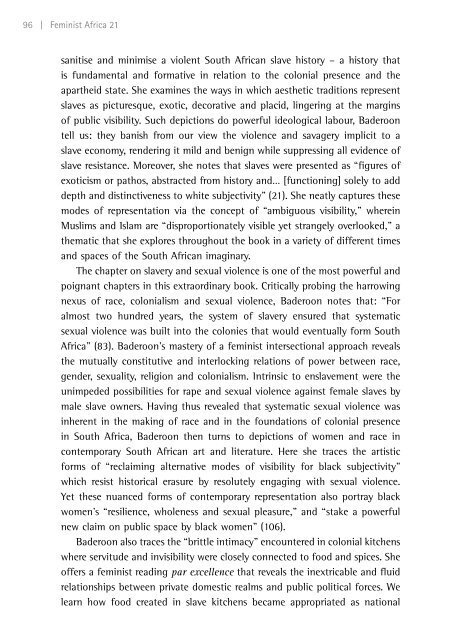The politics of fashion and beauty in Africa
fa21_proof_3
fa21_proof_3
You also want an ePaper? Increase the reach of your titles
YUMPU automatically turns print PDFs into web optimized ePapers that Google loves.
96 | Fem<strong>in</strong>ist <strong>Africa</strong> 21<br />
sanitise <strong>and</strong> m<strong>in</strong>imise a violent South <strong>Africa</strong>n slave history – a history that<br />
is fundamental <strong>and</strong> formative <strong>in</strong> relation to the colonial presence <strong>and</strong> the<br />
apartheid state. She exam<strong>in</strong>es the ways <strong>in</strong> which aesthetic traditions represent<br />
slaves as picturesque, exotic, decorative <strong>and</strong> placid, l<strong>in</strong>ger<strong>in</strong>g at the marg<strong>in</strong>s<br />
<strong>of</strong> public visibility. Such depictions do powerful ideological labour, Baderoon<br />
tell us: they banish from our view the violence <strong>and</strong> savagery implicit to a<br />
slave economy, render<strong>in</strong>g it mild <strong>and</strong> benign while suppress<strong>in</strong>g all evidence <strong>of</strong><br />
slave resistance. Moreover, she notes that slaves were presented as “figures <strong>of</strong><br />
exoticism or pathos, abstracted from history <strong>and</strong>… [function<strong>in</strong>g] solely to add<br />
depth <strong>and</strong> dist<strong>in</strong>ctiveness to white subjectivity” (21). She neatly captures these<br />
modes <strong>of</strong> representation via the concept <strong>of</strong> “ambiguous visibility,” where<strong>in</strong><br />
Muslims <strong>and</strong> Islam are “disproportionately visible yet strangely overlooked,” a<br />
thematic that she explores throughout the book <strong>in</strong> a variety <strong>of</strong> different times<br />
<strong>and</strong> spaces <strong>of</strong> the South <strong>Africa</strong>n imag<strong>in</strong>ary.<br />
<strong>The</strong> chapter on slavery <strong>and</strong> sexual violence is one <strong>of</strong> the most powerful <strong>and</strong><br />
poignant chapters <strong>in</strong> this extraord<strong>in</strong>ary book. Critically prob<strong>in</strong>g the harrow<strong>in</strong>g<br />
nexus <strong>of</strong> race, colonialism <strong>and</strong> sexual violence, Baderoon notes that: “For<br />
almost two hundred years, the system <strong>of</strong> slavery ensured that systematic<br />
sexual violence was built <strong>in</strong>to the colonies that would eventually form South<br />
<strong>Africa</strong>” (83). Baderoon’s mastery <strong>of</strong> a fem<strong>in</strong>ist <strong>in</strong>tersectional approach reveals<br />
the mutually constitutive <strong>and</strong> <strong>in</strong>terlock<strong>in</strong>g relations <strong>of</strong> power between race,<br />
gender, sexuality, religion <strong>and</strong> colonialism. Intr<strong>in</strong>sic to enslavement were the<br />
unimpeded possibilities for rape <strong>and</strong> sexual violence aga<strong>in</strong>st female slaves by<br />
male slave owners. Hav<strong>in</strong>g thus revealed that systematic sexual violence was<br />
<strong>in</strong>herent <strong>in</strong> the mak<strong>in</strong>g <strong>of</strong> race <strong>and</strong> <strong>in</strong> the foundations <strong>of</strong> colonial presence<br />
<strong>in</strong> South <strong>Africa</strong>, Baderoon then turns to depictions <strong>of</strong> women <strong>and</strong> race <strong>in</strong><br />
contemporary South <strong>Africa</strong>n art <strong>and</strong> literature. Here she traces the artistic<br />
forms <strong>of</strong> “reclaim<strong>in</strong>g alternative modes <strong>of</strong> visibility for black subjectivity”<br />
which resist historical erasure by resolutely engag<strong>in</strong>g with sexual violence.<br />
Yet these nuanced forms <strong>of</strong> contemporary representation also portray black<br />
women’s “resilience, wholeness <strong>and</strong> sexual pleasure,” <strong>and</strong> “stake a powerful<br />
new claim on public space by black women” (106).<br />
Baderoon also traces the “brittle <strong>in</strong>timacy” encountered <strong>in</strong> colonial kitchens<br />
where servitude <strong>and</strong> <strong>in</strong>visibility were closely connected to food <strong>and</strong> spices. She<br />
<strong>of</strong>fers a fem<strong>in</strong>ist read<strong>in</strong>g par excellence that reveals the <strong>in</strong>extricable <strong>and</strong> fluid<br />
relationships between private domestic realms <strong>and</strong> public political forces. We<br />
learn how food created <strong>in</strong> slave kitchens became appropriated as national



